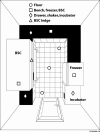Use of hydrogen peroxide vapor for deactivation of Mycobacterium tuberculosis in a biological safety cabinet and a room
- PMID: 17166957
- PMCID: PMC1829131
- DOI: 10.1128/JCM.01797-06
Use of hydrogen peroxide vapor for deactivation of Mycobacterium tuberculosis in a biological safety cabinet and a room
Abstract
Mycobacterium tuberculosis is an important human pathogen that is routinely cultured in clinical and research laboratories. M. tuberculosis can contaminate surfaces and is highly resistant to disinfection. We investigated whether hydrogen peroxide vapor (HPV) is effective for the deactivation of M. tuberculosis on experimentally contaminated surfaces in a biological safety cabinet (BSC) and a room. Biological indicators (BIs) consisting of an approximately 3-log(10) inoculum of M. tuberculosis on stainless steel discs and a 6-log(10) inoculum of Geobacillus stearothermophilus were exposed to HPV in BSC time course experiments and at 10 locations during room experiments. In three separate BSC experiments, M. tuberculosis BIs were transferred to growth media at 15-min intervals during a 180-min HPV exposure period. No M. tuberculosis BIs grew following 30 min of HPV exposure. In three separate room experiments, M. tuberculosis and G. stearothermophilus BIs were exposed to HPV for 90, 120, and 150 min, respectively. BIs for both microorganisms were deactivated in all 10 locations following 90 min of HPV exposure. HPV provides an alternative to traditional decontamination methods, such as formaldehyde fumigation, for laboratories and other areas contaminated with M. tuberculosis.
Figures
Similar articles
-
Decontamination with vaporized hydrogen peroxide is effective against Mycobacterium tuberculosis.Lett Appl Microbiol. 2005;40(6):448-52. doi: 10.1111/j.1472-765X.2005.01683.x. Lett Appl Microbiol. 2005. PMID: 15892741
-
Hazard Group 3 agent decontamination using hydrogen peroxide vapour in a class III microbiological safety cabinet.J Appl Microbiol. 2020 Jan;128(1):116-123. doi: 10.1111/jam.14461. Epub 2019 Oct 31. J Appl Microbiol. 2020. PMID: 31559683
-
Efficacy of dry mist of hydrogen peroxide (DMHP) against Mycobacterium tuberculosis and use of DMHP for routine decontamination of biosafety level 3 laboratories.J Clin Microbiol. 2008 Sep;46(9):2955-8. doi: 10.1128/JCM.00250-08. Epub 2008 Jul 16. J Clin Microbiol. 2008. PMID: 18632916 Free PMC article.
-
Biological safety cabinetry.Clin Microbiol Rev. 1991 Apr;4(2):207-41. doi: 10.1128/CMR.4.2.207. Clin Microbiol Rev. 1991. PMID: 2070345 Free PMC article. Review.
-
The risks and benefits of chemical fumigation in the health care environment.J Occup Environ Hyg. 2011 Feb;8(2):104-12. doi: 10.1080/15459624.2011.547453. J Occup Environ Hyg. 2011. PMID: 21253983 Review.
Cited by
-
Development of a highly effective low-cost vaporized hydrogen peroxide-based method for disinfection of personal protective equipment for their selective reuse during pandemics.Gut Pathog. 2020 Jun 19;12:29. doi: 10.1186/s13099-020-00367-4. eCollection 2020. Gut Pathog. 2020. PMID: 32572338 Free PMC article.
-
Survival of nosocomial bacteria and spores on surfaces and inactivation by hydrogen peroxide vapor.J Clin Microbiol. 2009 Jan;47(1):205-7. doi: 10.1128/JCM.02004-08. Epub 2008 Oct 29. J Clin Microbiol. 2009. PMID: 18971364 Free PMC article.
-
Review of Sterilization Techniques for Medical and Personal Protective Equipment Contaminated With SARS-CoV-2.IEEE Access. 2020 Jun 16;8:111347-111354. doi: 10.1109/ACCESS.2020.3002886. eCollection 2020. IEEE Access. 2020. PMID: 34192107 Free PMC article.
-
The Biosafety Research Road Map: The Search for Evidence to Support Practices in the Laboratory-Zoonotic Avian Influenza and Mycobacterium tuberculosis.Appl Biosaf. 2023 Sep 1;28(3):135-151. doi: 10.1089/apb.2022.0038. Epub 2023 Sep 12. Appl Biosaf. 2023. PMID: 37736423 Free PMC article. Review.
-
Use of hydrogen peroxide vapour & plasma irradiation in combination for quick decontamination of closed chambers.Indian J Med Res. 2016 Aug;144(2):245-249. doi: 10.4103/0971-5916.195039. Indian J Med Res. 2016. PMID: 27934804 Free PMC article.
References
-
- Advisory Committee on Dangerous Pathogens. 2000. Categorisation of biological agents according to hazard and categories of containment, 4th ed., 2nd suppl. HSE Books, Suffolk, United Kingdom.
-
- Archuleta, R. L., P. Mullens, and T. P. Primm. 2002. The relationship of temperature to desiccation and starvation tolerance of the Mycobacterium avium complex. Arch. Microbiol. 178:311-314. - PubMed
-
- Barry, C. E., R. A. Slayden, and K. Mdluli. 1998. Mechanisms of isoniazid resistance in Mycobacterium tuberculosis. Drug. Resist. Updates 1:128-134. - PubMed
-
- Brennan, P. J. 2003. Structure, function, and biogenesis of the cell wall of Mycobacterium tuberculosis. Tuberculosis 83:91-97. - PubMed
MeSH terms
Substances
LinkOut - more resources
Full Text Sources
Medical
Miscellaneous



